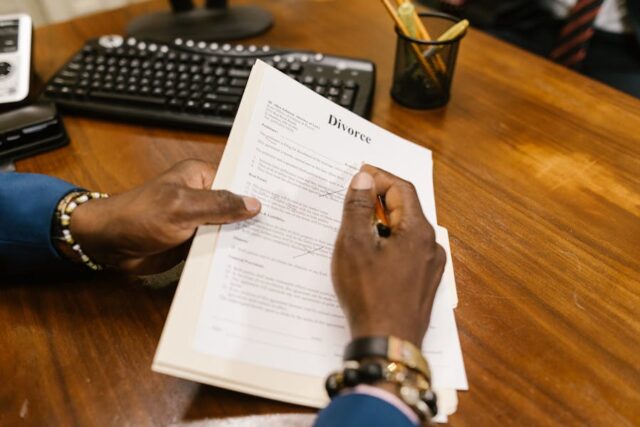Yes, you can obtain divorce papers at the courthouse. Simply visit your local courthouse and request to file the necessary documents. Ensure that you file in the correct county and be prepared to pay a filing fee along with the initial paperwork.
Navigating The Courthouse For Divorce Papers
Yes, you can obtain divorce papers at the courthouse. Simply visit your local courthouse and request the necessary documents to initiate the divorce process. It’s advisable to inquire about any specific requirements or fees associated with filing for divorce at the courthouse.
Navigating the Courthouse for Divorce Papers
Divorce can be a difficult and stressful process, and navigating the courthouse to obtain divorce papers can add to the confusion. However, with the right information and preparation, the process can be simplified. In this article, we will guide you on how to navigate the courthouse for divorce papers.
Locating the right department
The first step in obtaining divorce papers from the courthouse is to locate the right department. Typically, the department responsible for divorce filings is the family court. However, the specific department may vary depending on your location. It is advisable to call the courthouse ahead of time to confirm the location of the department.
Understanding courthouse procedures
Once you have located the right department, it is important to understand courthouse procedures. Courthouse procedures can be overwhelming, especially if it is your first time. Therefore, it is important to ask questions if you are unsure about anything.
When you arrive at the courthouse, you will need to fill out the necessary paperwork to initiate the divorce process. The paperwork will require information about you and your spouse, as well as the reason for the divorce. Additionally, you will need to pay a filing fee.
Ensuring each H3 heading adheres to HTML syntax
To ensure that each H3 heading adheres to HTML syntax, we can use the following code:
Locating The Right Department
Understanding Courthouse Procedures
In conclusion, obtaining divorce papers from the courthouse can be a daunting process. However, by knowing the right department and understanding courthouse procedures, the process can be simplified. If you have any questions or concerns, do not hesitate to ask courthouse staff for assistance.
Filing For Divorce: The Basics
To obtain divorce papers, visit your local courthouse and request the necessary documents for filing. Ensure to pay the required filing fee along with the initial paperwork. You can easily secure these papers at the courthouse to initiate the divorce process.
Starting With The Initial Paperwork
When filing for divorce at the courthouse, the process typically begins with completing the necessary paperwork. The specific documents required may vary based on your jurisdiction, but generally, the initial paperwork includes the petition or complaint for divorce. This document outlines the grounds for divorce and provides basic information about the parties involved.
Additionally, you may need to complete other forms such as a summons, which notifies the other party of the divorce filing, and any applicable financial disclosure forms. It’s crucial to ensure that all forms are accurately filled out and properly signed to avoid delays in the divorce process.
Dealing With Filing Fees
Along with the initial paperwork, individuals filing for divorce at the courthouse are typically required to pay a filing fee. The amount of the filing fee varies by jurisdiction and can also depend on whether there are additional motions or requests being filed simultaneously. It’s important to inquire about the accepted payment methods at the courthouse, as some may only accept cash or money orders.
Furthermore, individuals experiencing financial hardship may be eligible for a fee waiver, which can exempt them from paying the filing fee. This waiver is usually granted based on income level and requires the completion of specific forms to demonstrate financial need.
Divorce Paperwork Requirements
Yes, you can obtain divorce papers at the courthouse. Simply visit your local courthouse to file the necessary documents and pay the required fee. It’s a straightforward process to initiate your divorce proceedings efficiently.
When it comes to getting a divorce, one of the first steps is to gather and complete the necessary paperwork. Understanding the divorce paperwork requirements is crucial to ensure a smooth and efficient process. In this section, we will discuss the key aspects of completing your divorce forms and the required documents for filing.
Completing Your Divorce Forms
Completing your divorce forms accurately and thoroughly is essential to avoid any delays or complications in the divorce process. These forms typically include the Petition for Divorce, Summons, and any additional documents specific to your jurisdiction.
Here are some important points to consider when completing your divorce forms:
- Provide accurate and up-to-date personal information, including full names, addresses, and contact details.
- Clearly state your grounds for divorce, which may include irreconcilable differences, abandonment, or adultery, depending on your jurisdiction.
- Include all relevant information regarding child custody, visitation rights, child support, spousal support, and the division of assets and debts.
- Ensure that the forms are signed and dated by both parties involved in the divorce.
By carefully completing your divorce forms, you can streamline the process and avoid potential complications.
Required Documents For Filing
When filing for divorce, you will need to provide certain documents to the courthouse. These documents may vary depending on your jurisdiction, but some common requirements include:
- Proof of identification: You may need to provide a valid government-issued ID, such as a driver’s license or passport.
- Marriage certificate: You will typically need to present a copy of your marriage certificate to establish the legality of your marriage.
- Financial documents: This may include recent pay stubs, tax returns, bank statements, and documentation of assets and debts.
- Child-related documents: If you have children, you may be required to provide birth certificates, school records, and any existing custody or visitation agreements.
It is essential to check with your local courthouse or consult with an attorney to determine the specific documents required for filing in your jurisdiction. By ensuring that you have all the necessary documents in order, you can avoid unnecessary delays and complications in the divorce process.
In conclusion, understanding the divorce paperwork requirements is crucial when initiating the divorce process. By completing your divorce forms accurately and providing all the required documents for filing, you can ensure a smoother and more efficient divorce process. Consult with legal professionals or your local courthouse to obtain the specific requirements for your jurisdiction.
Serving Divorce Papers
You can obtain divorce papers at the courthouse by visiting your local courthouse and requesting the necessary documents for filing. Simply pay the required filing fee along with the initial paperwork to initiate the divorce process.
Traditional Methods Vs. Posting At The Courthouse
What To Do If You Can’t Find Your Spouse
When it comes to serving divorce papers, you may wonder about the options available to you. One method involves posting at the courthouse, while traditional methods also exist.
Traditional Methods Vs. Posting At The Courthouse
Traditional methods involve personally delivering the papers to your spouse. This can be done by a process server or through certified mail.
On the other hand, posting at the courthouse is an alternative if you cannot locate your spouse. This involves posting a notice of the divorce proceedings at a designated courthouse.
What To Do If You Can’t Find Your Spouse
If you are unable to find your spouse for the divorce proceedings, you can request permission from the court to serve the papers through posting at the courthouse.
- Contact the court clerk to inquire about the specific requirements for posting at the courthouse.
- Provide all relevant details and documentation to support your request for alternative service.
- Follow any additional steps or procedures as outlined by the court for serving the papers through posting.
By understanding the process of serving divorce papers and the options available to you, you can navigate this aspect of the divorce proceedings effectively.
Self-representation In Divorce Proceedings
Self-representation in divorce proceedings, also known as pro se representation, refers to individuals representing themselves in legal matters without the assistance of an attorney. This approach can be particularly relevant when seeking divorce papers at the courthouse. Understanding the advantages of self-representation and knowing how to access legal forms and assistance are crucial aspects of navigating the divorce process independently.
Advantages Of Self-representation
When individuals choose to represent themselves in divorce proceedings, they can benefit from several advantages, including:
- Direct control over the legal process and decision-making
- Cost savings associated with attorney fees
- Increased flexibility in managing the case
- Enhanced understanding of the legal proceedings
Accessing Legal Forms And Assistance
Obtaining divorce papers and accessing legal assistance at the courthouse is a fundamental step for those opting for self-representation. Courthouses typically provide access to essential legal forms and resources, including:
- Original Petition for Divorce
- Instructions for completing the forms
- Guidance on filing procedures
- Information on serving divorce papers
Furthermore, individuals can seek assistance from court personnel or online resources to navigate the process of obtaining and completing necessary documentation for their divorce proceedings.
Frequently Asked Questions
Can I File For Divorce At My Local Courthouse?
Yes, you can file for divorce at your local courthouse. Simply go there and request to file the necessary documents.
How Much Does It Cost To File For Divorce In Texas?
Filing for divorce in Texas costs around $300-$350, plus additional fees for serving papers.
What Is The First Step In Filing For Divorce In Texas?
To file for divorce in Texas, go to your local courthouse and ask to file the documents. Pay the filing fee with the initial paperwork.
How Long Does It Take To Get Divorced In Texas?
In Texas, the time to get divorced varies, usually taking about 60 to 180 days.
Can I Get Divorce Papers At The Courthouse?
Yes, you can obtain divorce papers at the courthouse. When you’re ready to file for divorce, simply go to your local courthouse and ask to file the necessary documents. Make sure to check the online questionnaire to ensure you’re filing in the correct county.
You will also need to pay a filing fee along with the initial paperwork.
How Much Does It Cost To File For Divorce In Texas?
The cost of filing for divorce in Texas varies depending on the county. On average, the filing fees range from $250 to $300. However, additional costs may arise if you require the assistance of an attorney or if there are any complexities in your case.
It’s best to consult with a legal professional to get an accurate estimate of the total cost.
Conclusion
Getting divorce papers at the courthouse is possible and relatively straightforward. Simply visit your local courthouse, pay the filing fee, and file the necessary documents. While the process may vary depending on your state and individual circumstances, it’s important to remember that seeking legal counsel and guidance can help make the process smoother.
By following the necessary steps and seeking the appropriate support, you can successfully navigate the process of obtaining divorce papers at the courthouse.














